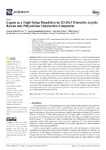Lignin as a high-value bioaditive in 3D-DLP printable acrylic resins and polyaniline conductive composite

Use this link to cite
http://hdl.handle.net/2183/32274
Except where otherwise noted, this item's license is described as Attribution 4.0 International (CC BY 4.0)
Collections
- Investigación (EPEF) [590]
Metadata
Show full item recordTitle
Lignin as a high-value bioaditive in 3D-DLP printable acrylic resins and polyaniline conductive compositeAuthor(s)
Date
2022-10-04Citation
Arias-Ferreiro, G.; Lasagabáster-Latorre, A.; Ares-Pernas, A.; Ligero, P.; García-Garabal, S.M.; Dopico-García, M.S.; Abad, M.-J. Lignin as a High-Value Bioaditive in 3D-DLP Printable Acrylic Resins and Polyaniline Conductive Composite. Polymers 2022, 14, 4164. https://doi.org/10.3390/polym14194164
Abstract
[Abstract]: With increasing environmental awareness, lignin will play a key role in the transition from the traditional materials industry towards sustainability and Industry 4.0, boosting the development of functional eco-friendly composites for future electronic devices. In this work, a detailed study of the effect of unmodified lignin on 3D printed light-curable acrylic composites was performed up to 4 wt.%. Lignin ratios below 3 wt.% could be easily and reproducibly printed on a digital light processing (DLP) printer, maintaining the flexibility and thermal stability of the pristine resin. These low lignin contents lead to 3D printed composites with smoother surfaces, improved hardness (Shore A increase ~5%), and higher wettability (contact angles decrease ~19.5%). Finally, 1 wt.% lignin was added into 3D printed acrylic resins containing 5 wt.% p-toluensulfonic doped polyaniline (pTSA-PANI). The lignin/pTSA-PANI/acrylic composite showed a clear improvement in the dispersion of the conductive filler, reducing the average surface roughness (Ra) by 61% and increasing the electrical conductivity by an order of magnitude (up to 10-6 S cm-1) compared to lignin free PANI composites. Thus, incorporating organosolv lignin from wood industry wastes as raw material into 3D printed photocurable resins represents a simple, low-cost potential application for the design of novel high-valued, bio-based products.
Keywords
Lignin
DLP
Polyaniline
Filler dispersibility
Additive manufacturing
Acrylic resin
DLP
Polyaniline
Filler dispersibility
Additive manufacturing
Acrylic resin
Editor version
Rights
Attribution 4.0 International (CC BY 4.0)
ISSN
2073-4360






